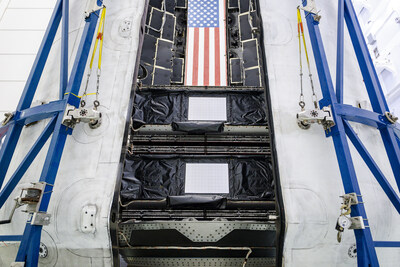Boeing preps spaceplane for next mission, launches satellites

The Boeing-built X-37B Orbital Test Vehicle (OTV) is preparing to launch its eighth mission (OTV-8) from Florida’s Space Coast, less than six months after the successful completion of OTV-7. OTV-8 will fly with a service module, expanding capacity for experiments and opening new opportunities for mission partners, which include the Air Force Research Laboratory and the Defense Innovation Unit.
Planned for launch no earlier than 21 August, the mission is set to host demonstrations of high-bandwidth inter-satellite laser communications technologies, as well as the highest performing quantum inertial sensor ever tested in space. The US Space Force will leverage insights from this mission to inform future space architectures.
“OTV-8’s laser communications demonstration will mark an important step in the US Space Force’s ability to leverage commercial space networks as part of proliferated, diversified and redundant space architectures,” said US Space Force Chief of Space Operations Gen Chance Saltzman. “In so doing, it will strengthen the resilience, reliability, adaptability and data transport speeds of our satellite communications architectures.”
The quantum inertial sensor will meanwhile demonstrate precise positioning, navigation and timing in a GPS-denied environment. Quantum inertial sensors, useful for navigation in deep and cis-lunar space, are set to push the technological frontiers of long-distance space travel and exploration.
“Whether navigating beyond Earth-based orbits in cis-lunar space or operating in GPS-denied environments, quantum inertial sensing allows for robust navigation capabilities where GPS navigation is not possible,” said Space Delta 9 Commander Colonel Ramsey Hom. “Ultimately, this technology contributes significantly to our thrust within the Fifth Space Operations Squadron and across the Space Force guaranteeing movement and manoeuvrability even in GPS-denied environments.”
The news comes shortly after Boeing confirmed that its ninth and 10th O3b mPOWER satellites, built for space solutions company SES, have successfully launched and are now transmitting signals from space. The satellites hitched a lift aboard a SpaceX Falcon 9 rocket, which left Earth on 22 July.

Having separated from the launch vehicle about two hours after lift off, the satellites have begun a 130-day journey to medium Earth orbit (MEO), approximately 8000 km from the Earth’s surface. There, they will join the first eight satellites in the O3b mPOWER constellation, which provide high-throughput, low-latency connectivity to SES users worldwide — mimicking the speed and reliability of traditional internet connections but with virtually unlimited geographic flexibility.
“We designed O3b mPOWER so each additional satellite beyond the first six boosts capacity, performance and resilience,” said Michelle Parker, Vice President, Boeing Space Mission Systems. “This capability stems from our investments in cutting-edge technology and the enhanced production techniques we’ve refined over the course of the program.”
The satellites leverage digitally formed beams to dynamically address evolving communication needs across geographies and customer bases. Boeing hardened this technology for military use on the Wideband Global SATCOM (WGS)-11 and WGS-12 and Evolved Strategic SATCOM (ESS) nuclear command and control satellites the company is building for the US Space Force. This software-defined technology allows for more secure and reliable connectivity resistant to attempts of jamming, interruption or interception.
“Over the past year, our O3b mPOWER services have been transforming industries and empowering our key customers including telco operators, cruise lines, airlines, NATO, the Government of Luxembourg, the Government of United States and many other allied governments,” said Adel Al-Saleh, CEO of SES. “With this launch we continue adding incremental capacity to our initial O3b mPOWER constellation, strengthening our MEO network and delivering high-throughput and predictable low-latency services at scale.”
Fleet comms enhanced for Alaskan fishing company
Inrico has delivered a customised communication system to the company, addressing the unique...
ACMA releases latest five-year spectrum outlook
The ACMA has released its Five-year spectrum outlook (FYSO) 2025–30, providing an overview...
It is possible to beam up quantum signals, scientists find
Quantum satellites currently beam entangled particles of light from space down to ground stations...




